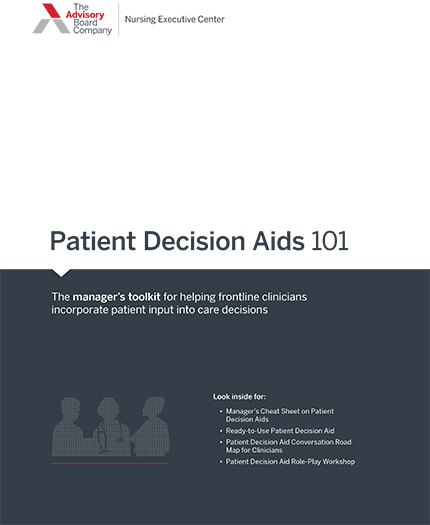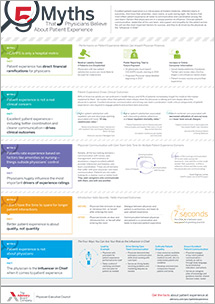Auto logout in seconds.
Continue LogoutPhysicians often find it difficult to help patients navigate health care decisions when there is little evidence to support a particular course of action—but providers can still take several approaches to guide patients through the "gray space," Dhruv Khullar, a physician at NewYork-Presbyterian Hospital and a researcher at the Weill Cornell Department of Healthcare Policy and Research, writes for the New York Times.
According to Khullar, patients and physicians wrestle with two major types of uncertainty: uncertainty of evidence, which refers to a lack of relevant data on a particular treatment, and uncertainty of outcomes, which refers to the odds that known data (say, 5% of patients with a certain pattern of symptoms will suffer a stroke this year) apply to a particular patient (will this patient be part of that 5%—or the 95% who don't suffer a stroke?).
Ultimately, providers must learn how to navigate both types of uncertainty with their patients, Khullar writes.
When evidence is unclear, physicians often encourage patients to make choices
According to Khullar, research suggests that the way patients weigh their medical options is heavily influenced by their physicians' recommendations—and that while nearly all patients want to know their care choices, the majority also want their provider to make the final call on treatment.
In particular, patients want more support from their physicians when there is significant uncertainty surrounding a treatment or service, Khullar writes. However, in such instances, doctors tend to "encourage patients to decide," according to Khullar.
Terri Fried, professor of medicine at Yale and a geriatrician at VA Connecticut Healthcare System, said, "Without good evidence, doctors say 'OK, you decide.'" However, Fried said, "Patients have no idea what to do with that. If we as doctors can't reason through the decision, how in the world can we expect patients to?"
Medical guidance often creates clear risk categories—but these may not align with patients' goals
According to Khullar, physicians generally decide whether to advise patients to seek or avoid a given treatment "by dividing a continuum of risk into categories that will trip a switch: a statin when you reach a 7.5% risk of a heart attack, a blood thinner when you're at 2% risk of a stroke." But providers are usually "less well trained to explore how a patient's fears and values intersect with the available evidence," he writes. One patient may think a 10% risk of heart attack is worth not having to take a pill every day, for instance, while another may find even a 1% risk "unacceptable."
In fact, according to Khullar, patient preferences in many instances "diverge substantially from guideline recommendations, which are created by researchers and policymakers with little input from patients on where to draw the line of acceptable risk." Yet "it's in using these guidelines that doctors make their strongest recommendations, while shying away from decisions where evidence is limited, and where their clinical experience and intuition may be most valuable," Khullar writes.
How to communicate uncertainty
It can be difficult for providers to help patients "navigate the gray space" of medical uncertainty, Khullar notes—but there are a few strategies that can help providers communicate risk.
For instance, Khullar suggests providers take care with the language they use when talking to patients about risk. According to Khullar, research indicates that patients find it easier to understand absolute risks rather than relative risks, and—although doctors tend to focus on the "upside"—patients are generally more sensitive to information about the harms of a treatment. Patients also feel more confident in their physicians when they address the uncertainty surrounding a particular treatment, Khullar writes, and patients are more likely to comprehend their choices when those options are presented sequentially rather than "all at once."
Physicians also can help patients assess their medical options by helping them identify what they value most when it comes to their treatment, based on their goals and preferences, Khullar writes. According to Khullar, the University of California-San Francisco uses this approach through a program called Scoped (Situations, Choices, Objectives, People, Evaluation, and Decisions), a decision-making process that improves patients' knowledge and satisfaction while easing anxiety.
Khullar explains, "Patients need to understand their values but also their possible futures—which is where clinician' experience and guidance may be most valuable." He adds, "The idea is not to reduce uncertainty, but to help patients clearly envision what life would look like in one outcome versus another, and to better prepare them for the various futures that might unfold."
According to Khullar, it might also be necessary to train physicians to "accept and convey uncertainty." He cites research showing that physicians uncomfortable with uncertainty "are more likely to experience work-related stress; withhold information from patients; and order more tests, procedures, and referrals." Ultimately, "what's certain is that uncertainty will always be with us," Khullar writes, and "when wading through medicine's expansive gray zones, patients could use a guide" (Khullar, "The Upshot," New York Times, 4/17).
5 myths physicians believe about patient experience
Excellent patient experience is a critical piece of modern medicine, reflected clearly in outcomes. And more than amenities, clean rooms, or quiet during night, the factors that most inflect patient experience all relate to communication and coordination among the care team—factors that physicians are in a unique position to influence.
See why clinician-patient communication, leadership of the care team, and support and empathy for the patient across the unit are the most important factors for success—and how physicians can embrace the role of "Influencer in Chief."
Don't miss out on the latest Advisory Board insights
Create your free account to access 1 resource, including the latest research and webinars.
Want access without creating an account?
You have 1 free members-only resource remaining this month.
1 free members-only resources remaining
1 free members-only resources remaining
You've reached your limit of free insights
Become a member to access all of Advisory Board's resources, events, and experts
Never miss out on the latest innovative health care content tailored to you.
Benefits include:
You've reached your limit of free insights
Become a member to access all of Advisory Board's resources, events, and experts
Never miss out on the latest innovative health care content tailored to you.
Benefits include:
This content is available through your Curated Research partnership with Advisory Board. Click on ‘view this resource’ to read the full piece
Email ask@advisory.com to learn more
Click on ‘Become a Member’ to learn about the benefits of a Full-Access partnership with Advisory Board
Never miss out on the latest innovative health care content tailored to you.
Benefits Include:
This is for members only. Learn more.
Click on ‘Become a Member’ to learn about the benefits of a Full-Access partnership with Advisory Board
Never miss out on the latest innovative health care content tailored to you.


